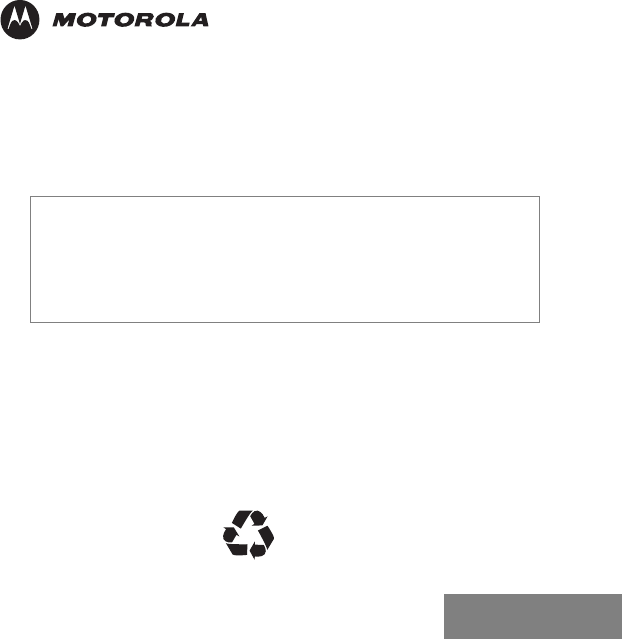Motorola Solutions 92FT7035 Mobile 2-Way Radio User Manual 6881095C99 G
Motorola Solutions, Inc. Mobile 2-Way Radio 6881095C99 G
Contents
- 1. Ex8a RF Safety Booklet
- 2. Ex8b User Manual
- 3. Ex8a User Manual amended
- 4. Ex 8b RF Safety Booklet amended
Ex 8b RF Safety Booklet amended

English
Product Safety and RF Energy Exposure Booklet
for Mobile Two-Way Radios Installed in Vehicles
or as Fixed Site Control Stations
ATTENTION!
The information provided in this document supersedes the general safety
information contained in user guides published prior to January 2008.
BEFORE USING THIS RADIO, READ THIS BOOKLET WHICH
CONTAINS IMPORTANT OPERATING INSTRUCTIONS FOR
SAFE USAGE AND RF ENERGY AWARENESS AND CONTROL
INFORMATION FOR COMPLIANCE WITH RF ENERGY
EXPOSURE LIMITS IN APPLICABLE NATIONAL AND
INTERNATIONAL STANDARDS.
© 2005 – 2009 by Motorola, Inc.
All rights reserved. 10/09
1301 E. Algonquin Rd., Schaumburg,
IL 60196-1078, U.S.A.
*6881095C99*
6881095C99-G
*NNTN7851B*
NNTN7851B
6881095C99-G.book Page 1 Friday, October 16, 2009 11:52 PM

2
English
RF Energy Exposure Awareness and Control Information,
and Operational Instructions for FCC Occupational Use
Requirements
NOTICE: This radio is intended for use in occupational/controlled
conditions, where users have full knowledge of their exposure and
can exercise control over their exposure to meet FCC limits. This
radio device is NOT authorized for general population, consumer,
or any other use.
This two-way radio uses electromagnetic energy in the radio frequency (RF)
spectrum to provide communications between two or more users over a distance.
It uses radio frequency (RF) energy or radio waves to send and receive calls. RF
energy is one form of electromagnetic energy. Other forms include, but are not
limited to, sunlight and x-rays. RF energy, however, should not be confused with
these other forms of electromagnetic energy, which when used improperly, can
cause biological damage. Very high levels of x-rays, for example, can damage
tissues and genetic material.
Experts in science, engineering, medicine, health, and industry work with
organizations to develop standards for safe exposure to RF energy. These
standards provide recommended levels of RF exposure for both workers and the
general public. These recommended RF exposure levels include substantial
margins of protection.
All Motorola two-way radios are designed, manufactured, and tested to ensure
they meet government-established RF exposure levels. In addition, manufacturers
also recommend specific operating instructions to users of two-way radios. These
instructions are important because they inform users about RF energy exposure
and provide simple procedures on how to control it.
6881095C99-G.book Page 2 Friday, October 16, 2009 11:52 PM

3English
Please refer to the following Web sites for more information on what RF energy
exposure is and how to control your exposure to assure compliance with
established RF exposure limits.
http://www.fcc.gov/oet/rfsafety/rf-faqs.html
http://www.osha.gov/SLTC/radiofrequencyradiation/index.html
Federal Communication Commission Regulations
The FCC rules require manufacturers to comply with the FCC RF energy
exposure limits for mobile two-way radios before they can be marketed in the
U.S. When two-way radios are used as a consequence of employment, the FCC
requires users to be fully aware of and able to control their exposure to meet
occupational requirements. Exposure awareness can be facilitated by the
use of a label directing users to specific user awareness information. Your
Motorola two-way radio has a RF exposure product label. Also, your Motorola
user manual, or separate safety booklet, includes information and operating
instructions required to control your RF exposure and to satisfy compliance
requirements.
Compliance with RF Exposure Standard
Your Motorola two-way radio is designed and tested to comply with a number of
national and international standards and guidelines (listed below) regarding
human exposure to radio frequency electromagnetic energy. This radio complies
with the IEEE and ICNIRP exposure limits for occupational/controlled RF
exposure environment at duty factors of up to 50% talk-50% listen and is
authorized by the FCC for occupational use. In terms of measuring RF energy for
compliance with the FCC exposure guidelines, your radio antenna radiates
measurable RF energy only while it is transmitting (during talking), not when it is
receiving (listening) or in standby mode.
6881095C99-G.book Page 3 Friday, October 16, 2009 11:52 PM

4
English
Your Motorola two-way radio complies with the following RF energy
exposure standards and guidelines:
• United States Federal Communications Commission, Code of Federal
Regulations; 47CFR part 2 sub-part J
• American National Standards Institute (ANSI)/Institute of Electrical and
Electronic Engineers (IEEE) C95. 1-1992
• Institute of Electrical and Electronic Engineers (IEEE) C95.1-1999 Edition
• Institute of Electrical and Electronic Engineers (IEEE) C95.1-2005 Edition
• International Commission on Non-Ionizing Radiation Protection (ICNIRP) 1998
• Ministry of Health (Canada) Safety Code 6. Limits of Human Exposure to
Radiofrequency Electromagnetic Fields in the Frequency Range from 3 kHz to
300 GHz, 1999
• Australian Communications Authority Radiocommunications (Electromagnetic
Radiation - Human Exposure) Standard, 2003
• ANATEL, Brasil Regulatory Authority, Resolution 256 (April 11, 2001) “additional
requirements for SMR, cellular, and PCS product certification”
RF Exposure Compliance and Control Guidelines and Operating
Instructions
To control exposure to yourself and others and to ensure compliance with the RF
exposure limits, always adhere to the following procedures.
Guidelines:
• User awareness instructions should accompany device when transferred to
other users.
• DO NOT use this device if the operational requirements described herein are
not met.
6881095C99-G.book Page 4 Friday, October 16, 2009 11:52 PM

5English
Instructions:
•Transmit no more than the rated duty factor of 50% of the time. To transmit
(talk), push the Push-To-Talk (PTT) button or, for radios equipped with VOX,
speak into the microphone. The red LED will illuminate when the radio is
transmitting. To receive calls, release the PTT button, or, for radios equipped
with VOX, stop talking. The red LED will extinguish when the radio stops
transmitting. Transmitting 50% of the time, or less, is important because this
radio generates measurable RF energy exposure only when transmitting (in
terms of measuring for standards compliance).
•Transmit only when people outside the vehicle are at least the
recommended minimum lateral distance away, as shown in Table 1, from
the body of a vehicle with a properly installed antenna. This separation
distance will ensure that there is sufficient distance from a properly installed
(according to installation instructions) externally-mounted antenna to satisfy
the RF exposure requirements in the standards listed above.
NOTE: Table 1 below lists the recommended lateral distance for people in an
uncontrolled environment from the body of a vehicle with an approved,
properly installed transmitting antenna (i.e., monopoles over a ground
plane, or dipoles) at several different ranges of rated radio power for
mobile radios installed in a vehicle.
Table 1. Rated Power of Vehicle-Installed Mobile Two-Way Radio and Recommended
Minimum Lateral Distance from Vehicle Body
Mobile Radio Rated
Power (see Note) Minimum Lateral Distance
from Vehicle Body
Less than 7 watts 8 inches (20 centimeters)
7 to 14 watts 1 foot (30 centimeters)
15 to 39 watts 2 feet (60 centimeters)
40 to 110 watts 3 feet (90 centimeters)
6881095C99-G.book Page 5 Friday, October 16, 2009 11:52 PM

6
English
• When a mobile radio is used in conjunction with another co-located transmitter such
as a Vehicular Repeater, it is the vehicle operator’s responsibility to take appropriate
steps to keep bystanders at the required separation distance from the vehicle to
ensure compliance with the FCC's RF energy exposure limits for the general
population. See the co-located transmitter’s user manual for more details.
NOTE: If you are not sure of the rated power of your radio, contact your Motorola
representative or dealer and supply the radio model number found on the
radio model label. If you can not determine the rated power out, then
assure 3-feet separation from the body of the vehicle. The maximum
power shown on the FCC Grant may be higher than the rated power
allowing for production variation.
Mobile Antenna Installation Guidelines
• These mobile antenna installation guidelines are limited to metal body motor
vehicles or vehicles with appropriate ground planes.
• Antennas should be installed in the center area of the roof or the trunk lid taking
into account exposure conditions of backseat passengers and according to the
specific instructions and restrictions in the Radio Installation Manual along with
the requirements of the antenna supplier.
• Trunk lid installations are limited to vehicles with clearly defined flat trunk lids,
and in some cases, to specific radio models and antennas. See the Radio
Installation Manual for specific information on how and where to install specific
types of approved antennas to facilitate recommended operating distances to
all potentially exposed persons.
•Use only the Motorola-approved, supplied antenna or a Motorola-
approved replacement antenna. Unauthorized antennas, modifications, or
attachments could damage the radio and may result in non-compliance with RF
Safety Standards.
6881095C99-G.book Page 6 Friday, October 16, 2009 11:52 PM

7English
Approved Accessories
• This radio has been tested and meets RF Safety Standards when used with the
Motorola accessories supplied or designated for this product. Use of other
accessories may result in non-compliance with RF Safety Standards.
• For a list of Motorola-approved antennas and accessories please refer to the
Users manual.
Additional Information
For additional information on exposure requirements or other training
information, visit http://www.motorola.com/rfhealth.
Compliance and Control Guidelines and Operating Instructions for
Mobile Two-Way Radios Installed as Fixed Site Control Stations
If mobile radio equipment is installed at a fixed location and operated as a control
station or as a fixed unit, the antenna installation must comply with the following
requirements in order to ensure optimal performance and compliance with the RF
energy exposure limits in the standards and guidelines listed on page 4:
• The antenna should be mounted outside the building on the roof or a tower if at
all possible.
• As with all fixed site antenna installations, it is the responsibility of the licensee
to manage the site in accordance with applicable regulatory requirements and
may require additional compliance actions such as site survey measurements,
signage, and site access restrictions in order to ensure that exposure limits are
not exceeded.
• For additional installation information, see the guidelines for minimum
separation distances provided above in the RF Exposure Compliance and
Control Guidelines and Operating Instructions section of this document.
6881095C99-G.book Page 7 Friday, October 16, 2009 11:52 PM

8
English
Electromagnetic Interference/Compatibility
NOTE: Nearly every electronic device is susceptible to electromagnetic
interference (EMI) if inadequately shielded, designed, or otherwise
configured for electromagnetic compatibility. It may be necessary to
conduct compatibility testing to determine if any electronic equipment used
in or around vehicles or near fixed site antenna is sensitive to external RF
energy or if any procedures need to be followed to eliminate or mitigate the
potential for interaction between the radio transmitter and the equipment
or device.
Facilities
To avoid electromagnetic interference and/or compatibility conflicts, turn off your
radio in any facility where posted notices instruct you to do so. Hospitals or
health care facilities may be using equipment that is sensitive to external RF energy.
Vehicles
To avoid possible interaction between the radio transmitter and any vehicle
electronic control modules, such as ABS, engine, or transmission controls, the
radio should be installed only by an experienced installer and the following
precautions should be used when installing the radio:
1. Refer to the manufacturer’s instructions or other technical bulletins for
recommendations on radio installation.
2. Before installing the radio, determine the location of the electronic control
modules and their harnesses in the vehicle.
3. Route all radio wiring, including the antenna transmission line, as far away as
possible from the electronic control units and associated wiring.
6881095C99-G.book Page 8 Friday, October 16, 2009 11:52 PM

9English
Driver Safety
Check the laws and regulations on the use of radios in the area where you drive.
Always obey them.
When using your radio while driving, please:
• Give full attention to driving and to the road.
• Pull off the road and park before making or answering a call if driving
conditions so require.
Operational Warnings
For Vehicles with an Air Bag
DO NOT mount or place a mobile radio in the area over an air bag
or in the air bag deployment area. Air bags inflate with great force.
If a radio is placed in the air bag deployment area and the air bag
inflates, the radio may be propelled with great force and cause
serious injury to occupants of the vehicle.
Potentially Explosive Atmospheres
Turn off your radio prior to entering any area with a potentially
explosive atmosphere. Sparks in a potentially explosive
atmosphere can cause an explosion or fire resulting in bodily
injury or even death.
The areas with potentially explosive atmospheres include fueling
areas such as below decks on boats, fuel or chemical transfer or
storage facilities, and areas where the air contains chemicals or
particles such as grain, dust or metal powders. Areas with
potentially explosive atmospheres are often, but not always,
posted.
W A R N I N G
6881095C99-G.book Page 9 Friday, October 16, 2009 11:52 PM

10
English
Blasting Caps and Blasting Areas
To avoid possible interference with blasting operations, turn off
your radio when you are near electrical blasting caps, in a blasting
area, or in areas posted: “Turn off two-way radio.” Obey all signs
and instructions.
For radios installed in vehicles fueled by liquefied petroleum gas,
refer to the (U.S.) National Fire Protection Association standard,
NFPA 58, for storage, handling, and/or container information. For a
copy of the LP-gas standard, NFPA 58, contact the National Fire
Protection Association, One Battery Park, Quincy, MA.
W A R N I N G
6881095C99-G.book Page 10 Friday, October 16, 2009 11:52 PM